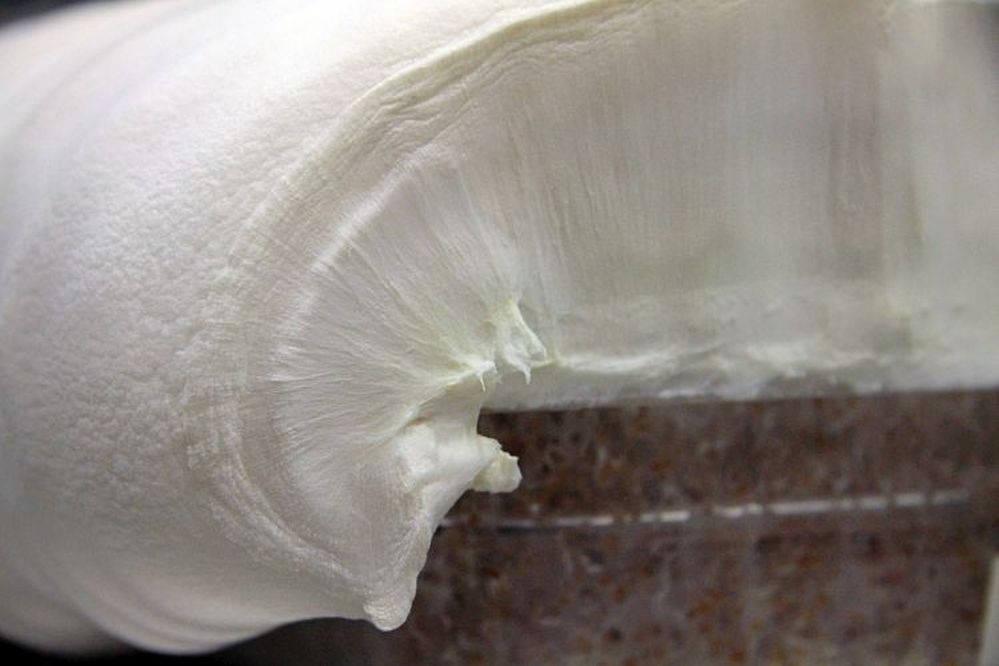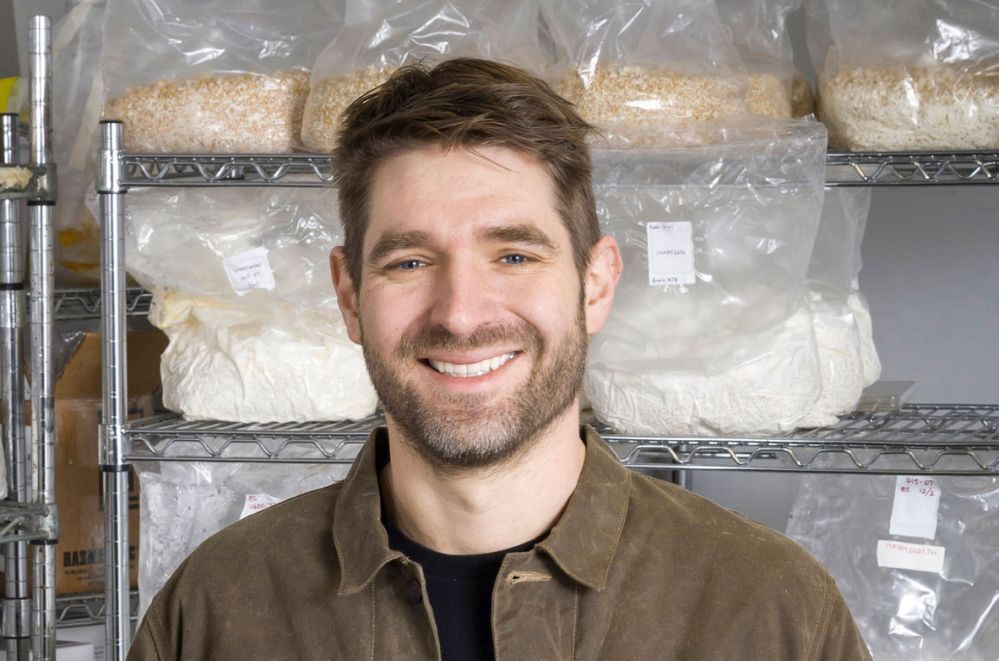Founded in 2007 by mechanical engineering students Eben Bayer and Gavin Mclntyre, Ecovative is one of several startups attempting to harness the magic of mycelium—the filament-like roots of mushrooms—to make more sustainable foods and materials. So what progress has it made to date?
AgFunderNews (AFN) caught up with Bayer (EB) to get the latest on mycelium-based hides under the Forager brand and mycelium-based bacon from MyForest Foods Co (spun out from Ecovative in 2020) under the MyBacon brand.
AFN: Give me the 60-second update…
EB: We have three farms now, our farm in New York, a partner farm in Europe, and a partner farm in Canada, all growing mycelium using our patented technology, so I think we can declare victory on this as a new industrial crop. But we still have a heck of a lot of work to do to get this fully deployed at scale.
The first few years were all about invention, then it was all about building a team and getting production set up. Now it’s about operating with excellence, quality, and reliability.
AFN: Ecovative recently raised a $30 million series E round led by Viking Global Investors of which $15 million went to MyForest Foods. How much runway does this give you?
EB: Our goal was to build the assets we needed to be able to make these businesses stand on their own and we did that, we’ve completed those assets. The next step is to operate those assets with sufficient scale and enough cash flow to get the business to a breakeven position. I think we’ll need to raise money one more time sometime this year.
AFN: Talk me through the production process for MyBacon. Rather than growing fungi in steel bioreactors fed with sugars, you’re growing slabs of mycelium ‘meat’ on beds of hardwood chips?
EB: We produce our own meat from Swersey Silos [the firm’s new ‘Air mycelium’ production facility in Green Island, New York], but we will also supply other facilities such as those run by our partner Whitecrest Mushrooms in Canada with the feedstock to grow their own mycelium meat; Whitecrest will be dedicating half of its mushroom production capacity to our AirMycelium technology this year.
AFN: How much processing is involved?
EB: Not much. What we have been doing is harvesting the mycelium at Swersey Silos then taking it to our facility [nearby] for further processing. But now we do some of that pre-processing on the farm [at Swersey Silos] so there are very few steps that are needed either for us to do or for co-manufacturers to do: it’s basically flavoring and packaging.

AFN: When is the MyBacon business going to reach meaningful scale?
EB: The capacity is coming online, it’s just taking longer to ramp up than we would like, and I’m sure you’ve heard this sob story before. But we have a partner farm [Whitecrest Mushrooms] coming online soon in Canada, and they’ve been testing for a year, so we’ve got a pretty good visibility on that.
AFN: Why are things moving more slowly than you’d like?
EB: We’re introducing a new industrial crop to the world, and I would say there are two key questions: What is your absolute maximum weekly production rate? And what is your confidence that you can sustain that production rate, week over week?
We’ve got a lot of capacity available but we are bringing it online in a way that makes sure we never drop below our weekly pack rate or short a vendor. And that process is different than the invention stage and the building stage in terms of the risk level you can tolerate.
It’s no one thing, so I can’t tell you, Oh, it’s widget number seven that didn’t work, right? There are thousands of interlinking parts that go into the supply chain and we have to keep fixing things until we have a system that works consistently. And then we’ll turn things up another click.
As an example, we have an input we buy from a third party that’s a biologic, and if that input is off, the mycelium won’t grow properly, which can impact our yields and the number of stores we can deliver to. So we have these long propagation cycles that we have to be very careful with and make sure we’re always coming off a conservative base.

AFN: You’ve just struck a deal with an equipment supplier called Limbraco?
EB: Limbraco is a vendor for the conventional mushroom industry that makes machines for harvesting and other operations. We built harvesting equipment to harvest our crops and Limbraco has now built its own version [for harvesting slabs of mushroom mycelium that MyForest Foods turns into MyBacon] using 100 years of mushroom industry know-how.
The great thing is that our partner in Canada, Whitecrest Mushrooms, has just ordered one [a Limbraco machine for harvesting mycelium] as part of a big capital project to convert part of their [conventional mushroom] farm to our [mushroom mycelium] technology. It’s all part of building a supply chain that supports this new crop and allowing this crop to scale massively.
If you picture it, you’ve got these big trays [of mushroom mycelium, grown using solid state fermentation] four feet wide and six inches tall. The machine squishes it a little bit to compress it to the density of pork and then cuts it off [the bed] so it can be processed.
AFN: Does the machine you’re using for MyBacon also work for harvesting the species of mycelium you use to make Forager hides?
EB: No, this is specifically for food. If we tried to run it on the crop for Forager, it would break the machine! For the hides, we have separately designed and built a machine that harvests sheets of mycelium off of beds with a giant saw.

AFN: You recently hired food industry veteran Greg Shewchuk to run MyForest Foods, what difference has that made?
EB: You only find out how little you know when you work with an expert. Greg has worked all over the food industry with big companies as well as startups. We released version 2.0 of MyBacon in September and velocity is going up. MyBacon is in over 300 stores now, mostly independents, but you can expect to see some announcements about chains in Q1.
The biggest issue we have is not being able to make enough product. We’re about twice the velocity of the market leader in plant-based bacon and we’re very similar to pork-based bacon both in terms of velocity and price against products that make the same sort of claims, so organic, premium, antibiotic-free, hormone-free.
MyBacon is a high-quality product with a short ingredient list [mushroom mycelium, coconut oil, sugar, natural flavor, salt] that tastes great and people are willing to pay for it.
AFN: Isn’t this a pretty challenging time to be launching in the US alt meat category?
EB: I think we’re in a very natural hype cycle. The sector was overhyped and products that weren’t good enough flooded the channel. But I think it will be next generation companies like MyForest Foods that are bringing a better value proposition to market that are going to drive a second wave.
AFN: What happened to MyJerky, your second food product?
EB: It’s ready to go, but we’re not launching it yet. I like to create new things every week and Greg basically reminded me that we have a product (MyBacon) that is just getting out there and we should focus on that [before introducing another food product in a different category].

AFN: What’s the latest on the textiles [Forager hides] side of the business at Ecovative?
EB: We’re scaling into commercial production this year. We have about 10 or 12 brand partners such as Ecco Leather and Pangaia that have invested with us over the past two years and they’re starting to get shipments of product that they had allocated.
We have these 50-foot-long sheets of mycelium using a different species [to that deployed in MyBacon] and we do some de-watering and then we ship the ‘hide’ to tanneries and they do their thing to it.
We have similar tensile strength and similar look and feel to calf hides, and I personally believe that our product is best-in-class among current leather alternatives, but there’s still some work to do on overall homogeneity. In MyBacon, the heterogeneous nature of the mycelium is a benefit, as people want it to look non-industrial, whereas for Forager hides, we basically want the opposite.
AFN: What part of the market are you going after?
EB: We are working with high-end brands, but our target for the hides side of the business is to be upper mass market, same as the bacon.
AFN: What progress are you making on the high-performance foams side of the business?
EB: Right now we’re focused on scaling the bacon and the hides, and trying hard to do those two things really well.




